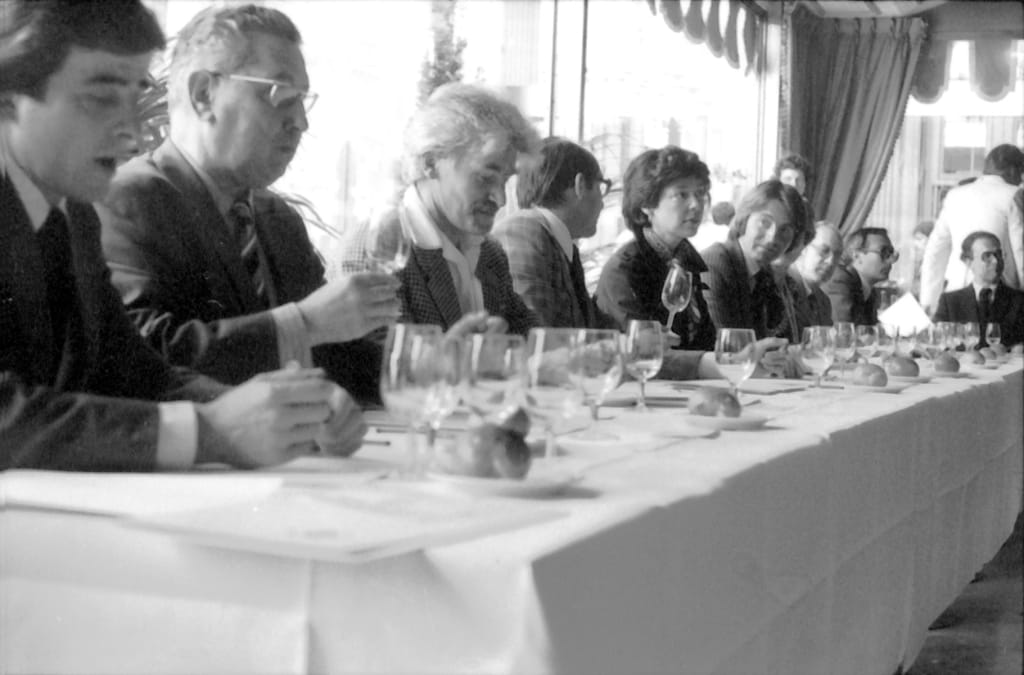The Judgement of Paris
Not the start of the Trojan War, but a 1976 wine tasting

Wine made anywhere other than Europe (particularly France) had always had a stigma attached to it, especially in the early 20th century. These days, though, you can find great wine at almost every price point from anywhere in the world. So, what changed?
Wine can be defined as an alcoholic drink made by the fermentation of the juice of fruits or berries. Most commonly wine is made out of grapes, and prior to the Columbian Exchange and colonialist interests, was primarily made in Europe and the Middle East. Humans have been harnessing the power of fermentation for millennia to make beverages safe to drink but have also been chasing the power of intoxication the final product holds.
One of the earliest known traces of wine dates back to 7000 BCE in a village in the Henan Province of China. Other early evidence of wine has been found in Iran and Sicily. Wine remained on the Eurasian continent until the 1500s, when explorers and colonialists began to plant European vine varieties (of the family Vinifera) in foreign soils. Beginning in the 1500s and ending in the 1800s, vines were planted in Mexico, South America, California, South Africa, New Zealand, and Australia.
Vitis Vinifera (the common grape vine native to the Mediterranean) is not the only grape bearing vine. When the first European explorers from Scandinavia arrived at the coast of North America in the 9th century, they were greeted by a plethora of native vines. As such, these Vikings referred to this new land as “Vinland”, specifically within two sagas: the Grenlinga Saga and Eirik’s Saga. In them, the narrators describe wild vines and wheat, growing in a climate that seemed to lack a winter frost. The grape vines described in these sagas would most probably have been Vitis Labrusca, one of Vitis Vinifera’s American equivalents.
By the 16th century more European settlers had arrived on the North American continent and were fascinated by the abundance of native vines. However, even though American vines such as Vitis Labrusca produced fruit, the wine made from them would not be to the tastes of many of the settlers. To solve this problem, the settlers imported cuttings of the European Vitis Vinifera to plant. Every attempt, though, failed completely. The European vines died of extreme climate, new vine diseases, and native pests; the most devasting of which was the phylloxera louse, which was brought from the New World to the Old and by the late 19th century had absolutely devasted the European vine population. The only successful solution to this pest was the grafting of European vines onto American rootstocks, as American varieties were resistant to phylloxera.
As grafting as an anti-phylloxera became more popular, the American wine industry began to grow slowly, especially in California. Jumping ahead to the end of Prohibition and the beginning of the Second World War, the American wine industry cycled through prosperity and decline before finding new energy in the 1970s. California saw a rise in new wineries established, both big and small, and the quality of wine produced improved, but its international reputation remained unchanged – that American wine was regarded as “not as good” as European, and especially French, wine.
That is until the Paris Wine Tasting of 1976, otherwise known as the Judgement of Paris (a reference to the Ancient Greek Myth that led to the Trojan War).
Organized by Steven Spurrier, an Englishman with a wine shop in Paris, the tasting featured some of France’s most prominent wine experts, including Odette Kahn, who was a leading authority on wine. The best Californian wines Spurrier could find were to be tasted against their nearest French equivalent e.g. white Burgundies against California Chardonnays, Grand Crus Chateaux Reds against California Cabernet Sauvignon. The tasting, however, would be blind, meaning that the labels and bottles were to be disguised and not recognisable to the tasters.
As the judges tasted their wines, many felt they were able to distinguish Californian from French, which was proven to not be the case. One judge proclaimed after sipping on a Napa Valley Chardonnay “Ah, back to France!”. When the votes were cast and counted, the results spoke for themselves; the Californian wines had ranked over the French in all categories. This tasting was a landmark event for American wines, as it proved that good wine can be grown and made anywhere, not just in France.
The French press who had attended the event left quietly, publishing nothing on the tasting, while George Taber, the only other journalist there, published the story for Time Magazine, calling it the Judgement of Paris.
While there had been similar tastings stateside where American wines had ranked above their French counterparts, the Judgement of Paris forced the French to consider that their winemaking traditions may be leaving them in the past, as the Americans forge a new way forward. The Yanks had beaten them at their own game, on their turf.
This event not only had massive implications for the American wine industry but also for the global industry. While French wine still enjoys its world-class status, it no longer holds the dominant position in the wine world. By 2003 the value of French exports was overtaken by wines from the New World for the first time. The American wine industry was worth $34.8 billion in 2017, in comparison to France, which was only worth $16.7 billion. The rise of varietal wines (naming wines by their grape variety rather than their region or style) in the United States also has some roots in the Paris tasting. Prior to the 1970s, American winemakers had named their wines in the French tradition e.g. naming their Chardonnays as Burgundies. After the Paris Judgement, however, the convention of naming wine after their grape variety was further solidified globally.
Wine grown and made in American now enjoys prestige once only reserved for the best French wine. It took over 300 years of trial and error, but the USA is now one of the biggest players in the global wine industry, with regions such as the Napa Valley now household names. American rootstock now protects Vitis Vinifera vines Europe and anywhere else infected with phylloxera and American wines are enjoyed next to European wine. American wine and the Paris Judgement essentially cemented the status of New World wine as being just as delicious as that of the Old World, starting a long-term boom in the industry that continues to this day.





Comments
There are no comments for this story
Be the first to respond and start the conversation.